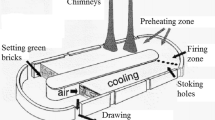Abstract
Utilization opportunities of perlite have made the product adaptable to numerous applications in the construction, industrial, chemical, horticultural and petrochemical industries. Applications of the perlite include filler, high and low temperature insulation, concrete aggregate, textured coatings, absorbent and carrier etc. Thus, perlite seems to be a very important material. In this paper, thermodynamics analysis of a perlite expansion furnace was performed. Both energy and exergy relations were derived for the considered system. Some parameters, such as losses, irreversibility and design etc., were used for determining the energy and exergy efficiencies. Based on the results of the analysis of the system, the energy and exergy efficiencies are calculated to be 66 and 26 %, respectively. Some recommendations were also made towards increasing the efficiency in the Turkish perlite industry.
Access this chapter
Tax calculation will be finalised at checkout
Purchases are for personal use only
Similar content being viewed by others
References
Cengel YA, Boles MA (2006) Thermodynamics: an engineering approach, 5th edn. McGraw-Hill, New York
Engin T, Ari V (2005) Energy auditing and recovery for dry type cement rotary kiln systems—a case study. Energy Convers Manag 46:551–562
Liu F, Ross M, Wang S (1995) Energy efficiency of Chine’s cement industry. Energy 20:669–681
Ates SA, Durakbasa NM (2012) Evaluation of corporate energy management practices of energy intensive in Turkey. Energy 45:81–91
Gutierrez AS, Martinez JBC, Vandecasteel C (2013) Energy and exergy assessments of a lime shaft kiln. Appl Thermal Eng 51:273–280
Çamdali Ü, Erişen A, Çelen F (2004) Energy and exergy analyses in a rotary burner with pre-calcinations in cement production. Energy Convers Manag 45:3017–3031
Utlu Z, Sogut Z, Hepbasli A, Oktay Z (2006) Energy and exergy analyses of a raw mill in a cement production. Appl Thermal Eng 26:2479–2489
Hepbasli A, Ozalp N (2003) Development of energy efficiency and management implementation in the Turkish industrial sector. Energy Convers Manag 44:231–249
Jegla Z, Stehlik P, Kohoutek J (2000) Plant energy saving through efficient retrofit of furnaces. Appl Thermal Eng 20:1545–1560
Sakamotoa Y, Tonookab Y, Yanagisawa Y (1999) Estimation of energy consumption for each process in the Japanese steel industry: a process analysis. Energy Convers Manag 40:1129–1140
Madlool NA, Saidur R, Rahim NA, Kamalisarvestani M (2013) An overview of energy savings measures for cement industries. Renew Sustain Energy Rev 19:18–29
Topçu IB, Işıkdağ B (2007) Manufacture of high heat conductivity resistant clay bricks containing perlite. Build Environ 42:3540–3546
Bejan A, Tsatsaronis G, Moran M (1996) Thermal design and optimization. Wiley, New York
Kotas TJ (1995) The exergy method of thermal plant analysis. Krieger Publishing, Malabar
Acknowledgement
Authors thank Fırat University Project Support Unit with the project number TEKF.13.01 and Aralçi Company in Elazig, Turkey for their valuable contribution to this work.
Author information
Authors and Affiliations
Corresponding author
Editor information
Editors and Affiliations
Nomenclature
Nomenclature
- A:
-
Area (m2)
- C p :
-
Specific heat (kJ/kg K)
- \( \dot{E}x \) :
-
Exergy rate (kW)
- e:
-
Specific energy (kJ/kg)
- \( \dot{E} \) :
-
Energy rate (kW)
- g:
-
Gravity (m/s2)
- Gr:
-
Grashof number
- h:
-
Specific enthalpy (kJ/kmol, kJ/kg)
- H:
-
Heat convection coefficient (W/m2 K)
- k:
-
Thermal conductivity (W/m K)
- LCV:
-
Low calorific value (kJ/kg)
- L:
-
Length (m)
- M:
-
Molar mass (kg/kmol)
- \( \dot{m} \) :
-
Mass flow rate (kg/s)
- Nu:
-
Nusselt number
- Pr:
-
Prandtl number
- \( \dot{Q} \) :
-
Heat flow rate (kW)
- Ra:
-
Rayleigh number
- \( \overline{R} \) :
-
Universal gas constant (kJ/kmol K)
- s:
-
Specific entropy (kJ/kg K)
- V:
-
Velocity (m/s)
- \( \dot{W} \) :
-
Work rate (kW)
- x:
-
Mole fraction
- σ :
-
Stefan–Boltzmann (W/m2 K4)
- ε :
-
Thermal diffusion
- λ :
-
Air–fuel ratio
- β :
-
Thermal expansion coefficient (1/K)
- υ :
-
Kinematic viscosity (m2/s)
- φ :
-
Ratio for industrial fuels
- η :
-
Energy efficiency
- η ex :
-
Exergy efficiency
- a:
-
Air
- cv:
-
Control volume
- c:
-
Convection
- D:
-
Destruction
- e:
-
Exit
- e.per:
-
Expanded perlite
- f:
-
Fuel
- i:
-
Inlet
- k:
-
k-th product
- l:
-
Loss
- NG:
-
Natural gas
- per:
-
Perlite
- p:
-
Combustion products
- r:
-
Radiation
- s:
-
Surface
- ∞ :
-
Environment
- ph:
-
Physical
- ch:
-
Chemical
Rights and permissions
Copyright information
© 2014 Springer International Publishing Switzerland
About this chapter
Cite this chapter
Gürtürk, M., Oztop, H.F., Hepbaslı, A. (2014). Energy and Exergy Analysis of a Perlite Expansion Furnace. In: Dincer, I., Midilli, A., Kucuk, H. (eds) Progress in Exergy, Energy, and the Environment. Springer, Cham. https://doi.org/10.1007/978-3-319-04681-5_28
Download citation
DOI: https://doi.org/10.1007/978-3-319-04681-5_28
Published:
Publisher Name: Springer, Cham
Print ISBN: 978-3-319-04680-8
Online ISBN: 978-3-319-04681-5
eBook Packages: EnergyEnergy (R0)




